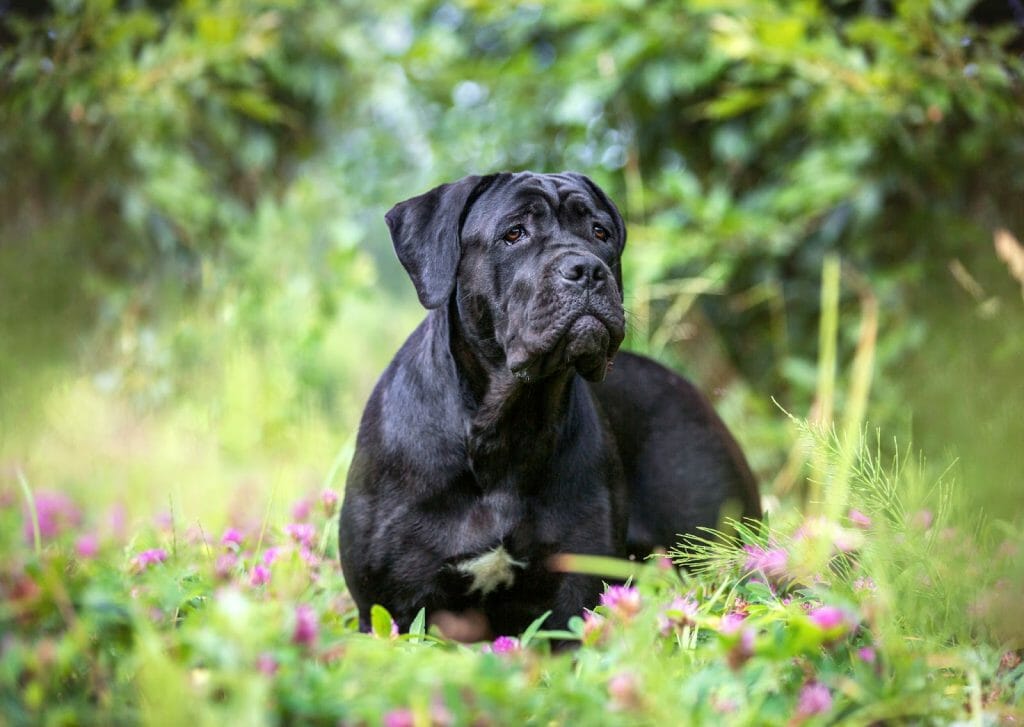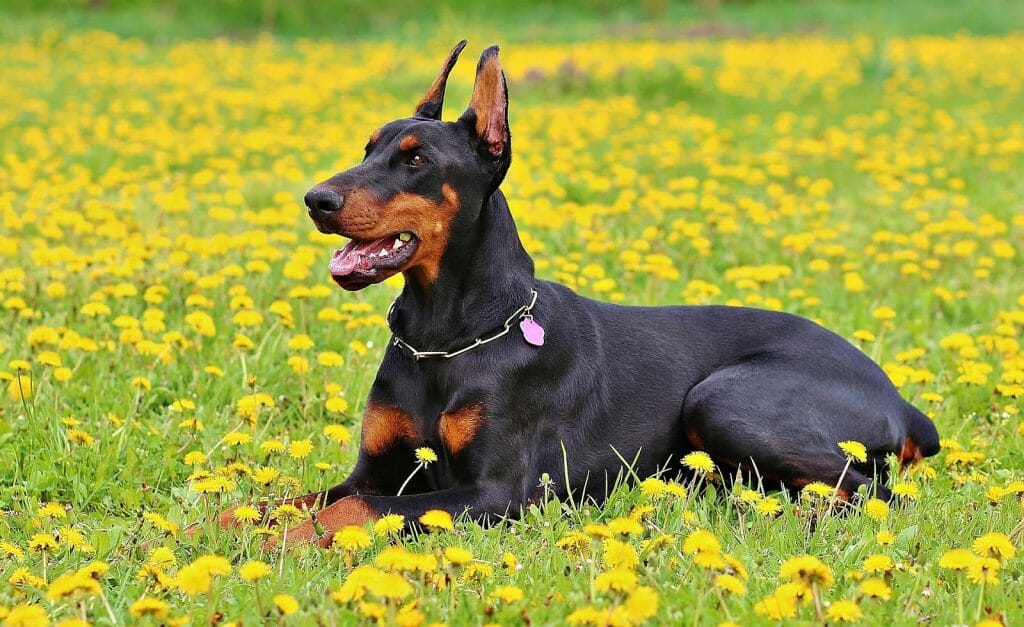Cane Corso vs Doberman: What Are Their Differences?
Both the Cane Corso and the Doberman are wonderful protection dogs that strongly contrast when it comes to appearance, temperament, and needs. Bringing one of them home is a huge responsibility and expect it to act far different from a small or medium-sized pooch.
Ready your home upon the arrival of any of these breeds, but before you head your way to the adoption center, see to it that your lifestyle matches your prospective dog. Find out more about their features and determine which between them is right for you.
Table of Contents
Breed Origins
Cane Corso
The Cane Corso dog is a native of Italy and a descendant of the Canis Pugnax, a Molossian canine that served as a war dog of the Romans. The breed’s name comes from the Latin word “cohors” which means “protector” or guardian.
True to its name, the Cane Corso indeed guarded the livestock of farmers as well as many homes and properties. One of his original purposes also includes being a hunting dog but he uses sight more than smell.
This Italian Mastiff almost became extinct during two world wars. Scarcity of food was rampant throughout Italy and owners could no longer feed their dogs. Thankfully, a few Cane Corsos remained present in Southern Italy in the 1970s. Efforts were made to restore the Mastiff and other breeds were used to strengthen its vigor.
Doberman
The Doberman or Doberman Pinscher is a new breed from Germany developed by Karl Freidrich Louis Dobermann as a protection dog whilst collecting taxes in broad daylight.
Unfortunately, he didn’t keep a record on what breeds he used to ultimately come up with the Doberman but what he was aiming for is to have an intelligent, brave, loyal, reliable, and even-tempered canine.
When the Doberman Pinscher was created, he proved himself to be a highly exceptional military, guard, and police dog. A good number of Dobermans were used as scouts and messengers during two world wars.
Size, Appearance, & Coloring
Cane Corso


A massive black Cane Corso with a white marking on the chest observing his domain
Cane Corsos can grow at an impressive height and weight. The American Kennel Club (AKC), however, has set the ideal measurements to help the breed thrive in good health. A full-grown Corso has a height of 23.5-27.5 inches and has a weight that is proportionate to his height.
You can never mistake this as a fragile dog due to how he exhibits a bulky, muscular appearance with a big, broad head. He has a very deep and wide muzzle and a sinewy neck that is slightly arched.
Cane Corsos can be black, brown, fawn, red, gray, chestnut brindle, black brindle, or gray brindle with a possibility of white markings appearing on the throat, chin, or chest.
Doberman


A black and rust Doberman sitting in a flower field
Dobermans are widely described as elegant thanks to their fit and muscular physique and smooth, glossy fur. They have pointed noses and long faces from a side profile with muscular chests that narrow to their stomachs. Some of them are docked and cropped to add a more frightening appearance.
In height at withers, an adult Doberman can reach 24-28 inches and weigh 60-100 pounds as per the AKC’s breed standards.
The natural colors of the breed are black, blue, red, and fawn with a combination of rust. Some can be purely white.
Temperament
Cane Corso
A confident Cane Corso is deemed a peerless protector. The AKC labels him as affectionate, intelligent, and majestic, all of which are true. He may look fearsome and menacing, but toward his family, this dog is a puppy at heart. The loyalty is unwavering when it comes to securing everyone’s safety at home.
With proper training, a Corso would be able to act and behave right without trying to take authority from his owner. He may, at times, test the limits of his master, but the right one should remain firm in giving commands. Socialization during puppyhood is the most critical training of all.
Doberman
A Doberman’s temperament varies a lot in terms of aggression and dominance. Since its history is composed of acting as an assistant for the military and police, some backyard breeders and drug dealers took advantage of the breed which resulted in it becoming more viscous.
Socialization and other early pieces of training are necessary so the breed would exhibit its protective nature only when needed. He’d love to be deeply involved with his family and would go to greater lengths to show his affection.
Exercise Needs
Cane Corso
Expect a bundle of energy out of this massive-sized canine. He’ll need to sweat off for an hour each day, but carefully choose activities that are not too vigorous. Puppies shouldn’t be encouraged to romp all they want or this would give long-term damage to their joints.
If you live in a hot country, take the dog out early in the morning or late in the afternoon, to avoid overheating.
Doberman
The way his body is built shows how much of an energetic athlete he is. Make him happy by giving him loads of exercise drills and time for free play. Due to his high energy levels, at least an hour and a half of sweating off each day is required.
Owners must not just focus on his physical needs but also give importance to his mental aspect by letting him join canine sports to make the most out of this breed.
Grooming Requirements
Cane Corso
The Corso is a double-coated dog that sheds throughout the year. He’s not high on grooming maintenance, however, and he’d be happy to be brushed a few times a week. Bathe him every 6-8 months to avoid doggy odor or whenever he’s dirty after a muddy playtime.
The rest of the routine must include regular nail trimming, ear cleaning, and teeth brushing.
Doberman
Dobermans shed but not as heavy as other breeds. He’s not a hypoallergenic dog either so monthly brushing is essential. Wipe down his coat to remove odor and to improve its quality.
Should you wash him, do so every few months only. Prevent him from having tooth decay and other sorts of infection by conducting a regular check-up on the ears and teeth. Don’t forget to keep the nails short as well for better posture.
Health Problems
Cane Corso
A Cane Corso that comes from a responsible breeder is relatively healthy. Unfortunately, since no breed is immune to health issues, you have to be aware that this dog is highly prone to Demodex mange, hip dysplasia, idiopathic epilepsy, and eyelid abnormalities.
Doberman
Dobermans are generally healthy dogs, but they may develop certain conditions at one point in their lives. Bloat is the most common issue and owners should be able to decipher the signs and symptoms it may show. Other genetic problems include hip dysplasia, dilated cardiomyopathy, von Willebrand’s disease, and hypothyroidism.
An experienced and trusted breeder should run tests on his stocks before starting the breeding program.
Breed Popularity
Below shows the AKC breed popularity ranking of the Cane Corso and the Doberman:
Cane Corso: 32nd
Doberman: 17th
